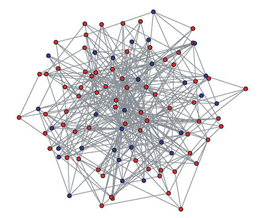Research Abstract
複雑ネットワークの動的頑強性:低次数ノードの重要な役割
Dynamical robustness in complex networks: the crucial role of low-degree nodes
2012年1月25日 Scientific Reports 2 : 232 doi: 10.1038/srep00232

社会的、生物学的、工学的ネットワークの多くは、非常に結合の多い少数の構成要素(ハブ)と、結合は少ないが非常に数が多い構成要素(低次数ノード)から成り立っている。複雑なネットワークの構造的頑強性に関しては、こうした不均質な結合を持つネットワークはハブの故障にきわめて脆弱なことがよく知られている。このようなネットワークが局所的な故障に対応して動的活動を維持する能力である動的頑強性については、十分に解明されていない。本論文では、不均質な結合を持つネットワークの非線形ダイナミクスが、構造的な脆弱性とは対照的に、低次数ノードの故障に対してきわめて脆弱な場合があることを示す。低次数ノードの役割が重要となるのは、近隣の(非活動的な)要素の故障を補うために正常な(活動的な)要素が自らの活動を低下させる動的プロセスがあるからである。我々の発見から、複雑ネットワークでの構造的頑強性と動的頑強性は大きく異なることが明らかになった。
- 東京大学生産技術研究所
- 東京大学大学院 情報理工学系研究科
Many social, biological, and technological networks consist of a small number of highly connected components (hubs) and a very large number of loosely connected components (low-degree nodes). It has been commonly recognized that such heterogeneously connected networks are extremely vulnerable to the failure of hubs in terms of structural robustness of complex networks. However, little is known about dynamical robustness, which refers to the ability of a network to maintain its dynamical activity against local perturbations. Here we demonstrate that, in contrast to the structural fragility, the nonlinear dynamics of heterogeneously connected networks can be highly vulnerable to the failure of low-degree nodes. The crucial role of low-degree nodes results from dynamical processes where normal (active) units compensate for the failure of neighboring (inactive) units at the expense of a reduction in their own activity. Our finding highlights the significant difference between structural and dynamical robustness in complex networks.

